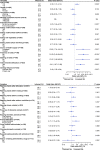Efficacy of triple dose albendazole treatment for soil-transmitted helminth infections
- PMID: 35960935
- PMCID: PMC9374461
- DOI: 10.1371/journal.pone.0272821
Efficacy of triple dose albendazole treatment for soil-transmitted helminth infections
Abstract
In Malaysia, soil-transmitted helminth (STH) infections still persist among indigenous communities. In the past, local studies have focused mostly on epidemiologic aspects of STH infections with a scarcity of information on the efficacy of deworming treatment. The present study consisted of 2 phases: a cross-sectional phase on current epidemiological status and risk factors of STH infections and a longitudinal study over 6 weeks on triple dose albendazole efficacy against STH infections. A total of 253 participants were recruited at baseline and a pre-tested questionnaire was administered to obtain information on socio-demographics, environmental and behavioural risk factors. Stool samples were evaluated using a modified Kato-Katz technique. Cure rate (CR) and egg reduction rate (ERR) were assessed at 3 weeks following a 3-day course of 400mg albendazole treatment and infection status were observed again at 6 weeks. Baseline positivity of trichuriasis, ascariasis and hookworm infections were 56.1%, 11.9% and 20.2%, respectively. Multivariate analysis showed age below 18 years old (P = 0.004), without latrine in house (P = 0.042) and indiscriminate defecation (P = 0.032) were associated with STH infections. In the longitudinal study (N = 89), CR for trichuriasis was 64.6%, while CR of 100% was observed for both ascariasis and hookworm. ERR was above 90% for all three STH species. A rapid increased of Trichuris trichiura egg output was observed at 6 weeks. In conclusion, STH infections are highly prevalent among indigenous communities. Children and teenagers, poor sanitation and hygiene behaviour were determinants for STH infections. Triple dose albendazole is found to be efficacious against Ascaris lumbricoides and hookworm infections but has moderate curative effect with high ERR against T. trichiura. Although triple dose albendazole regimen has logistic challenges and may not be a routine option, consideration of this treatment regime may still be necessary in selective communities to reduce high intensity of T. trichiura infection.
Conflict of interest statement
In accordance to PLOS ONE policies, we are reporting that one of our co-authors, Ken Cadwell has received research support from Pfizer, Takeda, Pacific Biosciences, Genentech, and Abbvie. Ken Cadwell has consulted for or received honoraria from Puretech Health, Genentech, and Abbvie. Ken Cadwell holds U.S. patent 10,722,600 and provisional patent 62/935,035 and 63/157,225. Ken Cadwell has consulted for or received an honoraria from Puretech Health, Genentech, Abbvie, GentiBio, and Synedgen. Ken Cadwell is an inventor on U.S. patent 10,722,600 and provisional patents 62/935,035 and 63/157,225. Other authors have declared that no competing interests exist. This does not alter our adherence to PLOS ONE policies on sharing data and materials.
Figures



Similar articles
-
Serious limitations of the current strategy to control Soil-Transmitted Helminths and added value of Ivermectin/Albendazole mass administration: A population-based observational study in Cameroon.PLoS Negl Trop Dis. 2020 Nov 3;14(11):e0008794. doi: 10.1371/journal.pntd.0008794. eCollection 2020 Nov. PLoS Negl Trop Dis. 2020. PMID: 33141853 Free PMC article.
-
Efficacy of albendazole against soil-transmitted helminth infections in Ethiopia: a systematic review and meta-analysis.Sci Rep. 2024 Sep 20;14(1):21970. doi: 10.1038/s41598-024-71308-3. Sci Rep. 2024. PMID: 39304661 Free PMC article.
-
Epidemiology and the effect of treatment of soil-transmitted helminthiasis in pregnant women in southern Thailand.Southeast Asian J Trop Med Public Health. 2009 Mar;40(2):211-22. Southeast Asian J Trop Med Public Health. 2009. PMID: 19323004
-
Comparison of real-time PCR and the Kato-Katz method for the diagnosis of soil-transmitted helminthiasis and assessment of cure in a randomized controlled trial.BMC Microbiol. 2020 Oct 2;20(1):298. doi: 10.1186/s12866-020-01963-9. BMC Microbiol. 2020. PMID: 33008301 Free PMC article. Clinical Trial.
-
Efficacy of current drugs against soil-transmitted helminth infections: systematic review and meta-analysis.JAMA. 2008 Apr 23;299(16):1937-48. doi: 10.1001/jama.299.16.1937. JAMA. 2008. PMID: 18430913
Cited by
-
Red palm olein-enriched biscuit supplementation lowers Ascaris lumbricoides reinfection at 6-month after anthelmintic treatment among schoolchildren with vitamin A deficiency (VAD).Acta Trop. 2023 Apr;240:106860. doi: 10.1016/j.actatropica.2023.106860. Epub 2023 Feb 10. Acta Trop. 2023. PMID: 36775004 Free PMC article. Clinical Trial.
-
A randomized assessors-blind clinical trial to evaluate the safety and the efficacy of albendazole alone and in combination with mebendazole or pyrantel for the treatment of Trichuris trichiura infection in school-aged children in Lambaréné and surroundings.Antimicrob Agents Chemother. 2024 May 2;68(5):e0121123. doi: 10.1128/aac.01211-23. Epub 2024 Apr 2. Antimicrob Agents Chemother. 2024. PMID: 38563751 Free PMC article. Clinical Trial.
-
Scaffolds imparting anthelmintic activity: recent advancements and SAR studies.Mol Divers. 2025 Feb;29(1):783-816. doi: 10.1007/s11030-024-10869-x. Epub 2024 Jul 31. Mol Divers. 2025. PMID: 39083219 Review.
-
Strong association between high burden of soil-transmitted helminthiasis and household transmission among Malaysian Negritos, urging anthelmintic treatment beyond children.Sci Rep. 2024 Nov 3;14(1):26535. doi: 10.1038/s41598-024-77127-w. Sci Rep. 2024. PMID: 39489727 Free PMC article.
-
Soil-Transmitted Helminth Infections among Antenatal Women in Primary Care Settings in Southern India: Prevalence, Associated Factors and Effect of Anti-Helminthic Treatment.Trop Med Infect Dis. 2023 Jan 7;8(1):48. doi: 10.3390/tropicalmed8010048. Trop Med Infect Dis. 2023. PMID: 36668955 Free PMC article.
References
-
- World Health Organization. Fact Sheet. Soil-transmitted helminth infections. 2021. [cited 2021 July 23]. Available from: https://www.who.int/en/news-room/fact-sheets/detail/soil-transmitted-hel....
-
- Silver ZA, Kaliappan SP, Samuel P, Venugopal S, Kang G, Sarkar R, et al.. Geographical distribution of soil transmitted helminths and the effects of community type in South Asia and South East Asia—A systematic review. PLoS Negl Trop Dis. 2018;12(1):e0006153. doi: 10.1371/journal.pntd.0006153 - DOI - PMC - PubMed
-
- Jamaiah I, Rohela M. Prevalence of intestinal parasites among members of the public in Kuala Lumpur, Malaysia. Southeast Asian J Trop Med Public Health. 2005;36:68–71. - PubMed
Publication types
MeSH terms
Substances
Grants and funding
LinkOut - more resources
Full Text Sources
Miscellaneous

